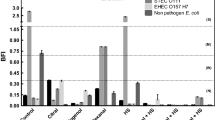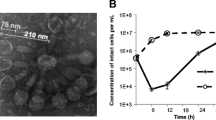Abstract
The effect of rapid and slow chilling on survival and nisin sensitivity was investigated in Escherichia coli. Membrane permeabilization induced by cold shock was assessed by uptake of the fluorescent dye 1-N-phenylnapthylamine. Slow chilling (2°C min−1) did not induce transient susceptibility to nisin. Combining rapid chilling (2,000°C min−1) and nisin causes a dose-dependent reduction in the population of cells in both exponential and stationary growth phases. A reduction of 6 log of exponentially growing cells was achieved with rapid chilling in the presence of 100 IU ml−1 nisin. Cells were more sensitive if nisin was present during stress. Nevertheless, addition of nisin to cell suspension after the rapid chilling produced up to 5 log of cell inactivation for exponentially growing cells and 1 log for stationary growing cells. This suggests that the rapid chilling strongly damaged the cell membrane by disrupting the outer membrane barrier, allowing the sensitization of E. coli to nisin post-rapid chilling. Measurements of membrane permeabilization showed a good correlation between the membrane alteration and nisin sensitivity. Application involving the simultaneous treatment with nisin and rapid cold shock could thus be of value in controlling Gram negatives, enhancing microbiological safety and stability.


Similar content being viewed by others
References
Abee T, Rombouts FM, Hugenholtz J, Guihard G, Letellier L (1994) Mode of action of nisin Z against Listeria monocytogenes Scott A grown at high and low temperatures. Appl Environ Microbiol 60:1962–1968
Alakomi HL, Skytta E, Saarela M, Mattila-Sandholm T, Latva-Kala K, Helander IM (2000) Lactic acid permeabilizes Gram-negative bacteria by disrupting the outer membrane. Appl Environ Microbiol 66:2001–2005
Belfiore C, Castellano P, Vignolo G (2007) Reduction of Escherichia coli population following treatment with bacteriocins from lactic acid bacteria and chelators. Food Microbiol 24:223–229
Boziaris IS, Adams MR (2000) Transient sensitivity to nisin in cold-shocked Gram negatives. Lett Appl Microbiol 31:233–237
Boziaris IS, Adams MR (2001) Temperature shock, injury and transient sensitivity to nisin in Gram negatives. J Appl Microbiol 91:715–724
Brewer R, Adams MR, Park SF (2002) Enhanced inactivation of Listeria monocytogenes by nisin in the presence of ethanol. Lett Appl Microbiol 34:18–21
Cao-Hoang L, Dumont F, Marechal PA, Le-Thanh M, Gervais P (2008) Rates of chilling to 0 degrees C: implications for the survival of microorganisms and relationship with membrane fluidity modifications. Appl Microbiol Biotechnol 77:1379–1387
Garcera MJ, Elferink MG, Driessen AJ, Konings WN (1993) In vitro pore-forming activity of the lantibiotic nisin. Role of protonmotive force and lipid composition. Eur J Biochem 212:417–422
Hancock RE, Farmer SW, Li ZS, Poole K (1991) Interaction of aminoglycosides with the outer membranes and purified lipopolysaccharide and OmpF porin of Escherichia coli. Antimicrob Agents Chemother 35:1309–1314
Helander IM, Mattila-Sandholm T (2000a) Fluorometric assessment of gram-negative bacterial permeabilization. J Appl Microbiol 88:213–219
Helander IM, Mattila-Sandholm T (2000b) Permeability barrier of the Gram-negative bacterial outer membrane with special reference to nisin. Int J Food Microbiol 60:153–161
Jack RW, Tagg JR, Ray B (1995) Bacteriocins of gram-positive bacteria. Microbiol Rev 59:171–200
Liang Z, Mittal GS, Griffiths MW (2002) Inactivation of Salmonella typhimurium in orange juice containing antimicrobial agents by pulsed electric field. J Food Prot 65:1081–1087
Lopez-Pedemonte TJ, Roig-Sagues AX, Trujillo AJ, Capellas M, Guamis B (2003) Inactivation of spores of Bacillus cereus in cheese by high hydrostatic pressure with the addition of nisin or lysozyme. J Dairy Sci 86:3075–3081
Modi KD, Chikindas ML, Montville TJ (2000) Sensitivity of nisin-resistant Listeria monocytogenes to heat and the synergistic action of heat and nisin. Lett Appl Microbiol 30:249–253
Papagianni M, Avramidis N, Filioussis G, Dasiou D, Ambrosiadis I (2006) Determination of bacteriocin activity with bioassays carried out on solid and liquid substrates: assessing the factor “indicator microorganism”. Microb Cell Fact 5:30
Rodriguez E, Arques JL, Nunez M, Gaya P, Medina M (2005) Combined effect of high-pressure treatments and bacteriocin-producing lactic acid bacteria on inactivation of Escherichia coli O157:H7 in raw-milk cheese. Appl Environ Microbiol 71:3399–3404
Sobrino-Lopez A, Martin-Belloso O (2006) Enhancing inactivation of Staphylococcus aureus in skim milk by combining high-intensity pulsed electric fields and nisin. J Food Prot 69:345–353
Ter steeg PF, Hellemons JC, Kok AE (1999) Synergistic actions of nisin, sublethal ultrahigh pressure, and reduced temperature on bacteria and yeast. Appl Environ Microbiol 65:4148–4154
Tsuchido T, Aoki I, Takano M (1989) Interaction of the fluorescent dye 1-N-phenylnaphthylamine with Escherichia coli cells during heat stress and recovery from heat stress. J Gen Microbiol 135:1941–1947
Acknowledgments
This work was supported by the Agence Universitaire de la Francophonie (AUF), the Vietnamese and French Ministries of Education and Training, and the Bourgogne region.
Author information
Authors and Affiliations
Corresponding author
Rights and permissions
About this article
Cite this article
Cao-Hoang, L., Marechal, P.A., Le-Thanh, M. et al. Synergistic action of rapid chilling and nisin on the inactivation of Escherichia coli . Appl Microbiol Biotechnol 79, 105–109 (2008). https://doi.org/10.1007/s00253-008-1402-9
Received:
Revised:
Accepted:
Published:
Issue Date:
DOI: https://doi.org/10.1007/s00253-008-1402-9




